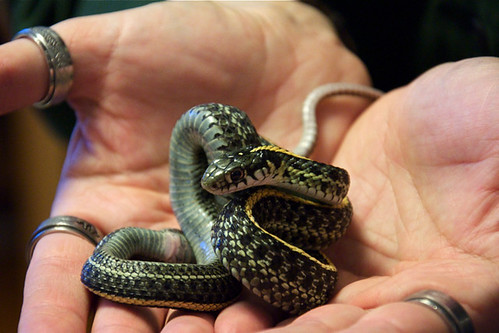George the garter snake, plus some gopher snake news
I’ve been tinkering with my home page today, taking care of little things that have lain fallow for too long. In doing so, I’ve noticed that I haven’t said anything about our snake collection since July. High time I rectified that. Let me tell you about George.
George, you may remember, is our male Plains Garter Snake (Thamnophis radix). We got him in February 2004, which means that we’ve had him for nearly five years. Frankly, I didn’t expect him to last this long: I mentioned two years ago this month that he had a subcutaneous lump that I assumed was a roundworm infestation, and he’s had a big lump just past his vent for years. To be honest, I’ve been expecting him to drop dead any day now for the past two years. If I’d had anything to say about him, it would go something like this: “George: still not dead.”
Because, you know, despite all expectations, he’s not. In many ways he looks terrible, because of his lumps; he’s also very floppy and has next to no muscle tone, even compared with the other garter snakes. But he eats, and he’s alert, and he’s good-natured. So what’s going on?
We now think that the big lump beneath his vent is a benign cyst or lump of fatty tissue, possibly a result of his all-mouse diet. As one of my few (if not my only remaining) wild-caught snake, he’d certainly be carrying an endoparasite load, but lumps on a snake due to a rich diet in captivity would not be unheard of — happens to Gray-Banded Kingsnakes all the time. We won’t know for sure until we perform a necroscopy on him, and for that he’s going to have to die. Which he shows no signs of being ready to do. (Now watch him drop dead as soon as I publish this.)
Incidentally, this is the first photo I’ve taken of him in his nearly five years with us.
In other news, the Great Basin Gopher Snakes, which, you may remember, I gave to Jeff and Jenny last March, have actually bred, with one egg actually hatching. I haven’t had snakes successfully breed here in years, and as soon as these two leave, then they get busy! Clearly, I’m doing something wrong. And it’s interesting that they had only one egg (out of several) hatch — that’s exactly what happened in 2002 and 2003, the last time the female laid eggs, and it’s kind of unusual.
